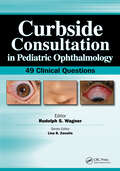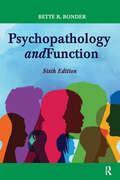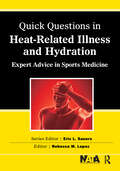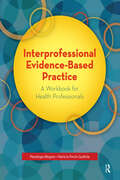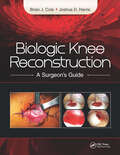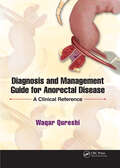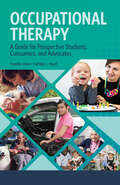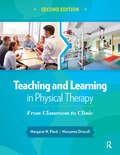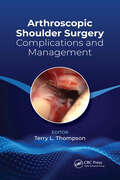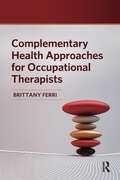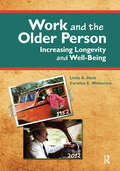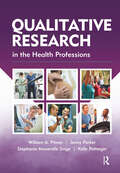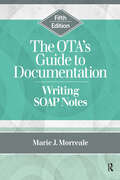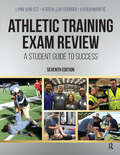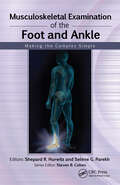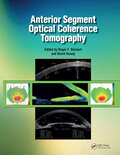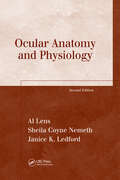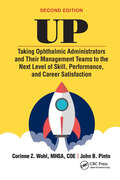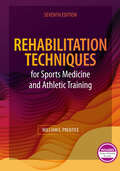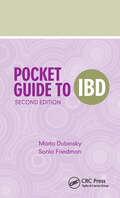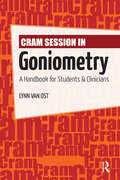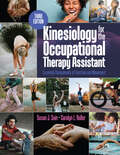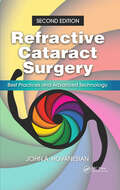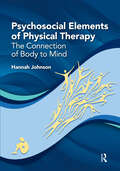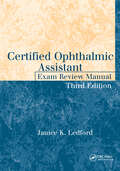- Table View
- List View
Curbside Consultation in Pediatric Ophthalmology: 49 Clinical Questions (Curbside Consultation in Pediatrics)
by Rudolph WagnerAre you looking for concise, practical answers to those questions that are often left unanswered by traditional pediatric ophthalmology references? Are you seeking brief, evidence-based advice for complicated cases or controversial decisions? Curbside Consultation in Pediatric Ophthalmology: 49 Clinical Questions provides quick answers to the tricky questions most commonly posed during a “curbside consultation” between pediatricians. Dr. Rudolph Wagner has designed this unique reference which offers expert advice, preferences, and opinions on tough clinical questions commonly associated with pediatric ophthalmology. The unique Q&A format provides quick access to current information related to pediatric ophthalmology with the simplicity of a conversation between two colleagues. Numerous images, diagrams, and references allow readers to browse large amounts of information in an expedited fashion. Some of the questions that are answered: • How do I make the diagnosis of amblyopia?• How can I differentiate a true strabismus from a pseudo-strabismus? • How do I diagnose and treat corneal abrasions? Does patching remain an important component of therapy?• What is naso-lacrimal duct obstruction? How is it managed? When should I refer these children? • How can I determine if a “red eye” is caused by a bacterial infection, viral infection or an allergic reaction? How are they managed?Curbside Consultation in Pediatric Ophthalmology: 49 Clinical Questions provides information basic enough for residents while also incorporating expert advice that even high-volume pediatricians will appreciate. Pediatricians, nurse practitioners, emergency room physicians, physician assistants and family practitioners will benefit from the user-friendly, casual format and the expert advice contained within.
Psychopathology and Function
by Bette BonderA comprehensive guide to understanding mental health, Psychopathology and Function, Sixth Edition offers helpful insights and strategies for occupational therapists to understand the approaches of other disciplines, such as medicine, physical therapy, social work, psychology, and nursing, and work effectively in the care team. An essential occupational therapy resource for more than 30 years, Dr. Bette Bonder’s Psychopathology and Function, Sixth Edition clearly describes occupational therapy’s unique perspectives and contributions to improving the lives of those struggling with emotional and psychological challenges. The Sixth Edition offers an overview of important research and discusses current and emerging issues and knowledge of mental health issues. Readers will gain an appreciation of the centrality of occupation and meaning to mental health and quality of life as they understand how occupational therapy can emphasize and assert its value. New updates in the Sixth Edition include: • Increased emphasis on issues of social justice • Incorporation of material about the impact of the COVID-19 pandemic on mental health issues • A new chapter on gender dysphoria • A new chapter on sociocultural factors in mental disorders • A streamlined and updated pharmacology chapter • A discussion about the DSM-5 and the reactions to it 5 years after its release A great resource for occupational therapy students and practitioners, Psychopathology and Function, Sixth Edition recognizes the importance of interventions focused on quality of life. This text offers background knowledge and strategies that can support efforts to address social and situational issues.
Quick Questions Heat-Related Illness: Expert Advice in Sports Medicine (Quick Questions in Sports Medicine)
by Rebecca LopezAre you looking for concise, practical answers to questions that are often left unanswered by traditional sports medicine references? Are you seeking brief, up-to-date, expert advice for common issues that can be encountered when working with athletes?Quick Questions in Heat-Related Illness and Hydration: Expert Advice in Sports Medicine provides a unique format of concise and to-the-point responses with clinical application, backed by the latest research on heat-related illnesses and hydration issues common among athletes. Dr. Rebecca M. Lopez and her contributors present 39 common clinical questions regarding topics such as how much and what kinds of fluids are optimal for performance and preventing illness, how to calculate an individual’s sweat rate, and the effect of supplements on hydration. Co-published with the National Athletic Trainers’ Association, Quick Questions in Heat Related Illness and Hydration: Expert Advice in Sports Medicine provides concise answers to 39 frequently asked clinical questions. Written in a conversational tone, the authors of the individual questions represent a variety of different backgrounds and are experts in their respective field. The variety of questions and brevity of responses will make this a book that is easy to read and reference at the point of care.Some sample sections and questions include: PreventionIs it possible to prevent death from exertional heat stroke? DiagnosisWhat temperature devices are valid when measuring internal body temperature in an exercising individual? Emergency managementDoes cold-water immersion cause shock or other adverse events? Environmental conditionsWhat are the best methods of assessing environmental conditions and what modifications should be made to work to rest ratios, practices and games based on the environment? Return to playWhat is the proper functional progression for an athlete returning to play following exertional heat stroke? HydrationWhat are the most practical, valid methods of measuring hydration status in athletes? Quick Questions in Heat-Related Illness and Hydration: Expert Advice in Sports Medicine is the perfect at-your-side resource for the athletic trainer, team physician, or sports medicine clinician looking for practical answers to heat-related illness and hydration questions. The concise and conversational tone allows the reader to readily apply the information into their everyday practice.
Interprofessional Evidence-Based Practice: A Workbook for Health Professionals
by Penelope Moyers Patricia Finch-GuthrieInterprofessional Evidence-Based Practice: A Workbook for Health Professionals promotes active, team learning of interprofessional evidence-based practice (EBP). This book is distinctive in that it departs from the tradition of evidence-based practice occurring from a single disciplinary perspective. Interprofessional evidence-based practice is described in terms of a dynamic team process that blends the patient’s preferences and values, the expertise of practitioners from multiple disciplines, and incorporates multidisciplinary evidence. Teams learn to use the nine phases in the interprofessional process to challenge current disciplinary paradigms and biases to create an integrated approach to patient care, healthcare delivery, or population health.Drs. Penelope Moyers and Patricia Finch Guthrie focus on developing and fostering collaboration between academic institutions and healthcare organizations so that students and faculty participate on interprofessional teams with mentors and staff from a healthcare organization. Interprofessional Evidence-Based Practice: A Workbook for Health Professionals also addresses the communication and cross-organizational factors important for supporting the work of the team. Common team and mentoring issues encountered in EBP are clearly articulated, along with the iterative problem-solving approaches necessary to mitigate temporary “stumbling blocks.”The book provides detail for developing and launching an Interprofessional Evidence-Based Practice program that goes beyond the evidence process to include implementation science to support practice change. Approaches for developing partnerships for supporting this type of program between universities and health care institutions are contained within, including sample partnership agreements and resource-sharing strategies.Inside Interprofessional Evidence-Based Practice: A Workbook for Health Professionals, each chapter includes performance objectives, key words, checklists, and materials and resources that an interprofessional team can use. PowerPoint lectures, mentor newsletters, forms, tools, and other resources are included on a companion website to guide team learning about key EBP topics, as well as to support the program coordinators and team mentors in their work with the interprofessional teams.Interprofessional Evidence-Based Practice: A Workbook for Health Professionals is the go-to resource for those who want to engage in interprofessional evidence-based practice, and for leaders who want to develop and implement an interprofessional evidence-based practice program.
Biologic Knee Reconstruction: A Surgeon's Guide
by Joshua Harris Brian ColeTreatment of articular cartilage pathology in the knees of young and active patients is a challenging and controversial issue. Biologic Knee Reconstruction: A Surgeon's Guide is a how-to, step-by-step guide that addresses the evaluation and management of this unique patient population. Internationally renowned cartilage experts Dr. Brian J. Cole and Dr. Joshua D. Harris, along with their contributors, present information on normal and abnormal history and physical examination. The reader will learn proper decision-making using a patient-centered approach of treatment, increasing the likelihood of a successful outcome. In addition to radiographic assessment of articular cartilage, Biologic Knee Reconstruction discusses the use of biomarkers, defect classification, and patient-reported and surgeon-measured outcomes. Aggressive nonsurgical medical management, including medications, injections, physiotherapy, and rehabilitation, is also presented.Biologic Knee Reconstruction also discusses the management of concomitant pathologies such as malalignment, meniscal deficiency, and ligamentous instability. Selection of surgical cartilage restorative treatment options is multifactorial, requiring consideration of several patient-, knee-, and defect-specific issues. All contemporary open and arthroscopic cartilage techniques are presented in detail with high resolution figures. A unique feature of Biologic Knee Reconstruction is the presentation of several chapters discussing non-medical issues highly pertinent to the advancement and future of this field: funding of research and cost of new advanced technologies, regulation of advanced cellular, tissue, and genetic technologies, evidence-based medicine and clinical trial design and conduct, and the ethics of allograft tissues and stem cell use.Features: Technique preference cards from the experts performing cartilage surgery Patient education information The most up-to-date descriptions of advanced cartilage techniques Unique chapters not covered in books elsewhere, including: Biomarkers Patient-reported outcomes assessment Newer injection techniques (PRP, stem cells) One- and two-stage open and arthroscopic techniques using chondrocyte- and stem cell based cell therapies Costs and public and private funding of research Barriers to high-quality randomized trials Governmental regulation and availability/accessibility to patients Gene therapy and tissue engineering Ethics of articular cartilage surgery with stem cells, ex-vivo cell manipulation, and juvenile tissue sources With the most up-to-date content and step-by-step methods for surgical procedures, Biologic Knee Reconstruction: A Surgeon's Guide is the perfect addition to the bookshelf of the orthopedic surgeon, cartilage researcher, sports physical therapist, or athletic trainer who evaluates and manages this unique patient population.
Diagnosis and Management Guide for Anorectal Disease: A Clinical Reference
by Waqar QureshiMany gastroenterologists are presented with patients complaining of one or more of several anorectal symptoms. Patients expect that a gastroenterologist can treat their symptomatic hemorrhoids or anal fissures or diagnose accurately their rectal bleeding. Today the evaluation and treatment of these common ailments is not included within the core curriculum of most gastrointestinal fellowship training programs, and therefore has not been incorporated into a typical GI practice. Diagnosis and Management Guide for Anorectal Disease: A Clinical Reference looks to fill that void. Dr. Waqar Ahmed Qureshi states that most of these perianal and anorectal problems can be successfully treated non-surgically. Diagnosis and Management Guide for Anorectal Disease: A Clinical Reference reviews a number of diseases that gastroenterologists should be able to effectively manage in their office, which eliminates extra cost, inconvenience, and frustration for their patients.A few of the topics that can be found inside: Anatomy and Examination Anatomy and Physiology of the Pelvic Floor Benign Anorectal Conditions Hemorrhoids, Anal Fissures, and Anal Pruritus Benign Soft Tissue, Perianal, Perineal, and Complicated Conditions Pilonidal Disease, Aanorectal IBD Management, and Defecation Disorders Neoplasms Anal Carcinoma and screening high-risk groups The gastroenterologist occupies a unique position between conservative treatment offered by primary care physicians and the more invasive procedures offered by the surgeon. Diagnosis and Management Guide for Anorectal Disease: A Clinical Reference is designed to provide a comprehensive understanding of anorectal diseases that they can manage and, therefore, improve the care of their patients in one comprehensive volume.
Occupational Therapy: A Guide for Prospective Students, Consumers, and Advocates
by Franklin Stein Kathlyn ReedA helpful resource that explains occupational therapy for students, clients, families, school counselors, and health professionals, Occupational Therapy: A Guide for Prospective Students, Consumers, and Advocates provides an understanding of what occupational therapists do to help people function in everyday activities. Written by esteemed authors Drs. Franklin Stein and Kathlyn L. Reed, Occupational Therapy: A Guide for Prospective Students, Consumers, and Advocates explains one of the fastest growing professions in the world. Featuring information on the specific interventions used in daily work, the educational requirements for becoming an occupational therapist, and the clinical settings where occupational therapists work, this book is the perfect introduction to the profession. Chapters are designed to educate prospective students about occupational therapy as well as the personal qualities needed to be an effective clinician. Detailed information is included with up-to-date facts great for sharing with those interested in this career. A glossary of terms at the conclusion assists students, consumers, and advocates who want to better understand the profession. Topics include: What is occupational therapy? Comparing occupational therapy to similar health professions What is the history of occupational therapy? Personal characteristics of occupational therapists Professional codes of ethics Occupational therapy clients The perfect companion book for any aspiring student or interested health professional, Occupational Therapy: A Guide for Prospective Students, Consumers, and Advocates is a great resource for all things occupational therapy.
Teaching and Learning in Physical Therapy: From Classroom to Clinic
by Margaret Plack Maryanne DriscollTeaching and Learning in Physical Therapy: From Classroom to Clinic, Second Edition is based on the teaching, research, and professional experiences of Drs. Margaret Plack and Maryanne Driscoll, who together have over 60 years of experience. More importantly it contains practical information that allows students, educators, and clinicians to develop optimal instructional strategies in a variety of settings. Clinical scenarios and reflective questions are interspersed throughout, providing opportunities for active learning, critical thinking, and immediate direct application.Grounded in current literature, the Second Edition is geared for physical therapists, physical therapist assistants, students, educators, and other health care professionals. By extending the principles of systematic effective instruction to facilitate critical thinking in the classroom and the clinic, and providing strategies to enhance communication and collaboration, the Second Edition has a strong theoretical basis in reflective practice, active learning strategies, and evidence-based instruction.Features: A user-friendly approach integrating theory and practical application throughout Classroom/clinical vignettes along with integrative problem solving activities and reflective questions to reinforce concepts Key points to remember and chapter summaries throughout Updated references and suggested readings at the end of each chapter Included with the text are online supplemental materials for faculty use in the classroom.In physical therapy, teaching and learning are lifelong processes. Whether you are a student, clinician, first time presenter, or experienced faculty member, you will find Teaching and Learning in Physical Therapy: From Classroom to Clinic, Second Edition useful for enhancing your skills both as a learner and as an educator in physical therapy.
Arthroscopic Shoulder Surgery: Complications and Management
by Terry ThompsonA comprehensive reference for the current surgical landscape of arthroscopic shoulder surgery, Arthroscopic Shoulder Surgery: Complications and Managementprovides expert opinions on the management of commonly encountered and unusual complications. As there is currently no other up-to-date resource dedicated wholly to complications in shoulder arthroscopy, this will become a go-to resource.Edited by Dr. Terry L. Thompson, alongside expert contributor perspectives on management and preferred treatment, Arthroscopic Shoulder Surgery is a great asset for any practicing orthopedic surgeon performing arthroscopic shoulder surgery, including fellowship-trained shoulder surgeons, sports medicine surgeons, orthopedic surgery residents, and sports medicine and shoulder fellows. By showcasing a broad range of complications and adverse outcomes, this text will assist with cases from adolescents through older adults.Each chapter in Arthroscopic Shoulder Surgery includes: Epidemiology Review of the literature Etiology Author’s preferred treatment with pearls Case presentations including radiographic and surgical images Arthroscopic Shoulder Surgery: Complications and Management is a necessary text discussing one of the most rapidly growing procedures in orthopedic surgery and meeting a need within the orthopedic community to discuss complications. Bringing together literature with tips and tricks from established leaders in shoulder surgery makes this an invaluable resource on handling complications of arthroscopic surgery of the shoulder.
Complementary Health Approaches for Occupational Therapists
by Brittany FerriComplementary Health Approaches for Occupational Therapists provides practitioners and students with foundational knowledge on complementary and integrative health. This guide is a great asset for occupational therapy students at the graduate level and practicing therapists wanting to incorporate these modalities into their treatment or to gain information regarding new trends in practice.Written by Brittany Ferri, MS, OTR/L, CCTP, this text enhances one’s occupational therapy education as it pertains to treatment addressing occupational performance. Introductory information is provided on more than 30 complementary and alternative modalities, including acupuncture, aquatic therapy, massage therapy, and tai chi. In Complementary Health Approaches for Occupational Therapists, each modality’s chapter includes: Basic guidelines for established complementary and alternative modalities that can be used in practice Literature reviews of the scientific benefits or lack thereof Credentials needed to practice, when applicable Contraindications, precautions, and side effects Practical applications in occupational therapy practice Included with the text are online supplemental materials for faculty use in the classroom.New modalities are constantly generating within occupational therapy. Complementary Health Approaches for Occupational Therapists will help differentiate between new modalities while also encouraging therapists to remain true to the roots of their profession in research and best practice.
Work and the Older Person: Increasing Longevity and Wellbeing
by Linda Hunt Caroline WolversonPart exploration, part knowledge building, and part narration, Work and the Older Person: Increasing Longevity and Well-Being draws on the latest research from a variety of disciplines and resources to paint a complete picture of productivity in old age. Dr. Linda A. Hunt and Caroline E. Wolverson, along with 11 contributors, discuss the relationship between work and aging and highlight the importance of working into old age. Each chapter of Work and the Older Person focuses on narratives from older workers that support the evidence presented with personal stories. These stories illustrate the opportunities, challenges, frustrations, and choices that older people face in maintaining a productive lifestyle. Simultaneously, the text highlights current events and the economy largely within Western societies and discusses the struggle some countries have supplying the financial benefits paid to retirees. Overall, the text shows how working into old age can contribute to longevity and greater quality of life. Occupational therapists, occupational therapy assistants, gerontologists, social workers, psychologists, and those working with older people in the health and social care sector will appreciate the inspiring accounts from older workers discussing how work contributes to their self-identity, quality of life, health, and well-being.Work and the Older Person: Increasing Longevity and Well-Being shows how engaging in occupations brings purpose to people’s lives. The text will be of value to all professionals working with older adults, as well as older adults themselves looking to maintain a productive lifestyle.
Qualitative Research in the Health Professions
by William Pitney Jenny Parker Stephanie Mazerolle Kelly PotteigerQualitative research can provide a great depth of understanding for health professionals in practice. Although many general research texts used in health discipline research courses present a broad spectrum of research methods, their discussion of qualitative methods is often limited. Qualitative Research in the Health Professions by Drs. William A. Pitney, Jenny Parker, Stephanie M. Mazerolle, and Kelly Potteiger, is a practical and straightforward text for those learning about qualitative research in the health professions. In Qualitative Research in the Health Professions, readers will acquire skills in mastering:• Introductory concepts of qualitative research, how it compares to quantitative research, and how to conceptualize a qualitative study • How to conduct a qualitative research study and present findings, including sections on collecting and analyzing data, ensuring trustworthiness of the data, and attending to ethical issues • Advanced concepts including various forms of qualitative research, how to mix quantitative and qualitative methods, and how to evaluate qualitative research Each chapter includes activities and exercises to further students’ understanding and the text also includes personal commentaries from scholarly practitioners in various health professions underscoring the value and importance of qualitative research. Qualitative Research in the Health Professionswill help current and future practitioners master the principles of qualitative research, understand published qualitative studies, and apply these findings in furthering evidence-based practice.
The OTA’s Guide to Documentation: Writing SOAP Notes
by Marie MorrealeThe bestselling, newly updated occupational therapy assistant (OTA) textbook, The OTA’s Guide to Documentation: Writing SOAP Notes, Fifth Edition explains the critical skill of documentation while offering multiple opportunities for OTA students to practice documentation through learning activities, worksheets, and bonus videos.The Fifth Edition contains step-by-step instruction on occupational therapy documentation and the legal, ethical, and professional documentation standards required for clinical practice and reimbursement of services. Students and professors alike can expect the same easy-to-read format from previous editions to aid OTAs in learning the purpose and standards of documentation throughout all stages of the occupational therapy process and different areas of clinical practice.Essentials of documentation, reimbursement, and best practice are reflected in the many examples presented throughout the text. Worksheets and learning activities provide the reader with multiple opportunities to practice observation skills and clinical reasoning, learn documentation methods, create occupation-based goals, and develop a repertoire of professional language.Templates are provided to assist beginning OTA students in formatting occupation-based SOAP notes, and the task of documentation is broken down into smaller units to make learning easier. Other formats and methods of recording client care are also explained, such as the use of electronic health records and narrative notes. This text also presents an overview of the initial evaluation process delineating the roles of the OT and OTA and guidelines for implementing appropriate interventions.New in the Fifth Edition: Incorporation of the Occupational Therapy Practice Framework: Domain and Process, Fourth Edition and other updated American Occupational Therapy Association documents Updated information to meet Medicare Part B and other third-party payer requirements Revised clinical terminology on par with current trends Added examples from emerging practice areas Expanded tables along with new worksheets and learning activities Included with the text are online supplemental materials for faculty use in the classroom, this includes: access to supplemental website worksheets, learning activities, and scenario-based videos to practice the documentation process.
Athletic Training Exam Review: A Student Guide to Success
by Lynn Van Ost Karen Lew Feirman Karen ManfriFor more than 20 years, Athletic Training Exam Review has empowered and enabled students to assess and evaluate their athletic training knowledge, skills, and decision-making abilities. Now, newly updated for its platinum anniversary, the Seventh Edition continues a tradition of excellence while serving as a premier guide to successfully achieving certification as an athletic trainer.The Seventh Edition serves as a comprehensive self-evaluation tool, elevating readers’ level of preparation for the BOC exam. This market-leading guide has made a positive impact on the athletic training profession by highlighting and improving students’ strengths and weaknesses.What’s inside: Updated study techniques and test-taking strategies An expanded overview of the exam format to assist in organization and planning More than 1,300 multiple-choice questions and nearly 100 true/false questions, updated and organized according to the BOC’s Practice Analysis, Seventh Edition Educational Domains Clinical decision-making questions testing the ability to make appropriate judgment calls using problem solving A skills assessment composed of 26 problems designed to test manual athletic training skills Scenario-based problems to strengthen critical-thinking abilities In addition to the updated content, the Seventh Edition also features a fully redesigned and expanded online test-taking experience, including: New user-friendly, mobile format 8 knowledge assessment tests—3 more than the previous edition! 5 unique true/false exams 20 total drag and drop identification photographs—8 more than the previous edition! 43 critical-thinking scenarios 3 clinical decision-making exams containing scenario-based exam questions 13 video segments with related questions for practicing evaluation and assessment Athletic Training Exam Review has assisted thousands of students and has become a hallmark text around the globe. Connecting the classroom with clinical education, this review tool is a timely and critical text that prepares students for their exam and career as an athletic trainer.
Musculoskeletal Examination of the Foot and Ankle: Making the Complex Simple
by Shepard Hurwitz Selene ParekhThe physical examination of the foot and ankle can be a complex topic for professionals with all levels of clinical experience. How can advance concepts be taught in a user-friendly, clear format, while still providing necessary information for effective diagnosis and treatment of the foot and ankle?Musculoskeletal Examination of the Foot and Ankle: Making the Complex Simple by Drs. Shepard Hurwitz and Selene Parekh answers these questions. Written by experts, this easy-to-carry book provides a quick and thorough review of the most common pathologic foot and ankle conditions, techniques for diagnosis, as well as the appropriate treatment for each condition.Musculoskeletal Examination of the Foot and Ankle: Making the Complex Simple contains clear photographic demonstrations, tables, sidebars, and charts throughout its pages, allowing a thorough and concise examination of the foot and ankle.A glance at some of what is covered inside:• Physical Examinationo Basics and specific tests of the foot and ankle• General Imagingo Basic interpretation of common imaging modalities of the foot and ankle• Common Conditionso Bunions, toe deformities, Achilles pathology and posterior calcaneal pain, fractures, plantar fasciitis and plantar heel pain, and moreMusculoskeletal Examination of the Foot and Ankle: Making the Complex Simple contains essential information to successfully take a complex subject, and bring it to a level that will be welcomed by orthopedic residents, faculty, physical therapists, athletic trainers, medical students interested in musculoskeletal health careers, and other health care providers.
Anterior Segment Optical Coherence Tomography
by David Huang Roger SteinertHigh-speed anterior segment optical coherence tomography (OCT) offers a non-contact method for high resolution cross-sectional and three-dimensional imaging of the cornea and the anterior segment of the eye. As the first text completely devoted to this topic, Anterior Segment Optical Coherence Tomography comprehensively explains both the scientific principles and the clinical applications of this exciting and advancing technology.Anterior Segment Optical Coherence Tomography enhances surgical planning and postoperative care for a variety of anterior segment applications by expertly explaining how abnormalities in the anterior chamber angle, cornea, iris, and lens can be identified and evaluated using the Visante OCT™.Inside Anterior Segment Optical Coherence Tomography, Dr. Roger Steinert and Dr. David Huang, along with 22 of the field's leading professionals, provide a wealth of useful clinical and physiological material about this new diagnostic imaging technique. Valuable images are included to assist in the pre- and postoperative assessment of various anterior segment disorders. Additionally, this unique resource contains detailed information on biometric measurements to enhance diagnostic capability.On the leading edge of anterior segment imaging: Mapping of corneal thickness and keratoconus evaluation Measurement of LASIK flap and stromal bed thickness Visualization and measurement of anterior chamber angle and diagnosis of narrow angle glaucoma Measuring the dimensions of the anterior chamber and assessing the fit of intraocular lens implants Visualizing and measuring the results of corneal implants and lamellar procedures Imaging through corneal opacity to see internal eye structures With the increase in popularity of anterior chamber imaging, and anterior segment OCT proving to be the best tool for high resolution biometry, Anterior Segment Optical Coherence Tomography is a must-have for anterior segment, refractive, cornea, and glaucoma surgeons.
Ocular Anatomy and Physiology (The Basic Bookshelf for Eyecare Professionals)
by Janice K. Ledford Al Lens Sheila Coyne NemethUpdated to include new material for beginners in ophthalmology and optometry, Ocular Anatomy and Physiology, Second Edition is an essential text that covers a range of fundamental information for students and clinicians. With collaborations from Al Lens, Sheila Coyne Nemeth, and Janice K. Ledford, Ocular Anatomy and Physiology, Second Edition now begins with a jump-start chapter to overview the topic for those new to the field of eye care. Chapter two delves into embryology—a topic rarely covered—and addresses each structure of the eye, including the bony orbit, eyebrows, eye lids, lacrimal system, extraocular muscles, and the globe. While the text continues to emphasize normal anatomy, each chapter contains a glossary of common disorders. Also included is a description of diagnostic methods for examining various tissues. The physiology of various structures and systems is explained, including the visual pathway, the inflammatory response, immunology, binocular vision, refractive errors, and accommodation. To enhance the reader’s understanding of each topic, illustrations are provided.Features of the Second Edition: New jump-start chapter for beginners Details on diagnostic methods for each structure or segment, including optical coherence tomography and retinal thickness analysis Glossary of common disorders at the end of each chapter With new features and information, Ocular Anatomy and Physiology, Second Edition is a valuable text for ophthalmic and optometric assistants, training facilities, and practices, as well as beginners in the field of eye care, including sales representatives and pre-med students.
UP: Taking Ophthalmic Administrators and Their Management Teams to the Next Level of Skill, Performance and Career Satisfaction
by John B. Pinto Corinne WohlLike having an expert mentor in your pocket, UP is a powerful, practical workbook designed to take ophthalmic administrators and practice managers to the next level of their careers, offering practical tips, concrete advice, and a step-by-step guide for any hurdle they face. Authors Corinne Wohl and John Pinto are undisputed experts in the field, having decades of experience advising ophthalmic practices of all sizes and publishing numerous books and articles on the subject. In this book, Wohl and Pinto guide administrators toward best practices in coaching and developing their entire management team. UP is also a helpful tool for physician leaders (and leaders in training), who can only accomplish their board-level goals through effective lay managers.UP provides readers with: Practical tips on how to create a customized support and development program for each manager and administrator A step-by-step process for better problem solving Worksheets, insightful self-tests, and scorecards for immediate use as part of a linear career development program
Rehabilitation Techniques for Sports Medicine and Athletic Training
by William PrenticeRehabilitation Techniques for Sports Medicine and Athletic Training, Seventh Edition is the definitive reference for athletic training students and professionals who are interested in gaining more in-depth exposure to the theory and practical application of rehabilitation techniques used in a sports medicine environment.Dr. William Prentice and his contributors have combined their knowledge and expertise to produce a single text that encompasses all aspects of sports medicine rehabilitation. Featuring more than 1,000 full-color illustrations, 700 high-resolution videos, and an integrated laboratory manual, this newly updated Seventh Edition provides the athletic trainer with a complete guide to the design, implementation, and supervision of rehabilitation programs for sport-related injuries.The Seventh Edition includes new and updated information on topics including:• Pharmacology and the role of medication in pain management and performance• Nutrition and its impact on rehabilitation• Rehabilitation techniques for the core • Roles within the rehabilitation team• Pathomechanics and epidemiology of common injuries• Psychological considerations and communication with injured patients• Tips for documentation from Dr. Prentice Included with the text are online supplemental materials for faculty use in the classroom.Rehabilitation Techniques for Sports Medicine and Athletic Training, Seventh Editionis a comprehensive resource for athletic training students, faculty, and clinicians; physical therapists who manage rehabilitation programs for sports-related injuries; as well as for strength and conditioning coaches who supervise performance enhancement programs on return to play.
Pocket Guide to IBD
by Sonia Friedman Marla DubinskyPocket Guide to IBD, Second Edition is designed to provide quick clinical information for gastroenterologists, primary care physicians, physician assistants, and nurse practitioners who need to review symptoms, medications, and disease management, in order to decide effective diagnoses and treatments for their patients with IBD.Some of the topics covered are:• Special populations, including pregnancy and children• Vaccinations in the patient with IBD• Treatment of the infliximab refractory patient• Diagnosis and treatment of perianal disease• Care of the post operative patientDr. Marla Dubinsky and Dr. Sonia Friedman have created this go-to reference for one of the most popular topics among practicing gastroenterologists and other GI and primary care providers.Features:• Comprehensive chapters in quick reference format• Symptom-based guide for diagnosis and treatment • Tables highlighting the full array of IBD medications • Charts and figures detailing complete treatment algorithmsThe Pocket Guide to IBD, Second Edition is unique in its size, accessibility of information, thoroughness, and clarity of content. This clinical guide will be the quick reference to turn to when treating patients with IBD.
Cram Session in Goniometry: A Handbook for Students and Clinicians
by Lynn Van OstWhen all you need is a basic understanding of goniometry. When concise and illustrative examples of goniometric techniques will provide exactly what the rehabilitation professional needs—Look to Cram Session in Goniometry: A Handbook for Students and Clinicians for quick and “at your fingertips” facts.Cram Session in Goniometry by Lynn Van Ost is a concise and abundantly illustrated quick reference which provides the rehabilitation professional with a very basic approach to various goniometric techniques. Organized in a “head to toe” format, Cram Session in Goniometry takes user-friendly and efficient learning to a new level.What is in your “Cram Session”:• Photographs depicting each goniometric measurement• Breakdown of each body region covered• Each type of joint, capsular pattern, average range of motion, patient positioning, goniometric alignment, patient substitutions, and alternative methods of measurement• Over 190 photographsCram Session in Goniometry: A Handbook for Students and Clinicians is an informative, well-organized handbook for all students and clinicians in physical therapy, occupational therapy, athletic training and orthopedics.
Kinesiology for the Occupational Therapy Assistant: Essential Components of Function and Movement
by Susan Sain Carolyn RollerThe only kinesiology book written by occupational therapy practitioners for the occupational therapy assistant is back with the Third Edition.Kinesiology for the Occupational Therapy Assistant: Essential Components of Function and Movement, Third Edition approaches the study of kinesiology by connecting function to the underlying components that make movement possible.This text uses a top-down approach to showcase the functional level of a client and then guides the reader to ascertain what fundamental kinesiological functions may be causing limitations or decreased engagement in daily activities. Occupational profiles introduce occupational therapy assistant students to real-life patients and describe occupational therapy treatment and patient outcomes. The reader will gain insight into the practice of occupational therapy through solving problems and developing questions needed to assist the client to achieve movement-related goals in tasks, activities, and occupations.What’s included in the Third Edition:• Updates to reflect AOTA’s model curricula for basic sciences and the OTPF-4. • Chapters on kinesiology and therapeutic exercise as well as functional mobility in the home and community.• Emphasis on function and identification of how and why movement occurs.• Select standardized tests, pinch and grip strength, and range of motion norms are noted where appropriate.Included with the text are online supplemental materials for faculty use in the classroom.Kinesiology for the Occupational Therapy Assistant: Essential Components of Function and Movement, Third Edition is a one-of-a-kind text that will enable occupational therapy assistant students to identify the underlying components that make movement possible.
Refractive Cataract Surgery: Best Practices and Advanced Technology
by John HovanesianUpdated and expanded, this Second Edition of Refractive Cataract Surgery: Best Practices and Advanced Technology is a practical guide for cataract surgeons and general ophthalmologists who wish to take their practices to a new level by offering refractive solutions to their cataract patients. All chapters have been updated to provide the latest information on premium surgery, including how-to chapters on extended depth-of-focus implants, intraoperative aberrometry, and femtosecond laser surgery. Both well-established and cutting-edge implants and techniques are presented in chapters that are organized by topic and detailed step-by-step. Dr. John A. Hovanesian and his contributors include enhancement strategies such as piggyback lenses, laser enhancement, and incisional surgery which are presented as separate and complete solutions. In addition to surgical strategies, Refractive Cataract Surgery, Second Edition explains the psychology of creating a premium practice. Non-technical matters such as patient screening, ethics, communicating the value of lenses, and managing the unhappy patient are thoroughly presented with easy-to-adopt ideas. New in the Second Edition: Intraoperative aberrometry Femtosecond laser cataract surgery Diagnostic and management tools for ocular surface disease Extended depth-of-focus implants Updated information on Tecnis toric, Trulign, and other accommodating IOLs Advice on various pricing models Refractive Cataract Surgery: Best Practices and Advanced Technology, Second Edition explores every angle of premium surgery and practice and offers improvements for all levels of surgeons, from the resident to the experienced physician, resulting in a top experience and a lifetime of premium vision for the patient.
Psychosocial Elements of Physical Therapy: The Connection of Body to Mind
by Hannah JohnsonPhysical therapists know that their patients are more than just a list of symptoms. They are people first, often with a complex mix of medical and psychiatric circumstances, who may receive a wide range of care from a team of professionals. Keeping this in mind, Psychosocial Elements of Physical Therapy: The Connection of Body to Mind is both a textbook and a clinical resource for physical therapist students and clinicians practicing in any patient population with psychological concerns or disorders.Inside, Dr. Hannah Johnson provides an essential introduction of psychosocial concepts, general treatment approaches for culturally sensitive care, and selected classes of mental illness as defined by the Diagnostic and Statistical Manual of Mental Disorders, 5th Edition (DSM-5). A complete review of the current research and evidence base provides students a strong foundation to build their careers on, but can also act as a crash-course in the most recent literature for the busy clinician.Features: Clear, concise language and layout for efficient learning Application-based review questions Real world case studies to apply critical thinking skills Evidence-based practical tests and measures Vocabulary terms that facilitate interdisciplinary teamwork Psychosocial Elements of Physical Therapy: The Connection of Body to Mind provides physical therapist students and clinicians with an efficient yet comprehensive guide to helping patients with psychological concerns or disorders.
Certified Ophthalmic Assistant Exam Review Manual (The Basic Bookshelf for Eyecare Professionals)
by Janice K. LedfordThe best-selling exam preparation manual for more than 15 years has been extensively updated into a Third Edition. With revisions and additional material that match the new JCAHPO® criteria for Certified Ophthalmic Assistants (COA®), this study resource will remain the top choice for those studying for certification. With nearly 1,400 questions, the Certified Ophthalmic Assistant Exam Review Manual, Third Edition contains more questions with explanatory answers than any other study aid. Additionally, all 19 exam criteria headings are covered inside, including history taking, visual assessment, medical ethics, pharmacology, ophthalmic imaging, surgery, and more. Features:• Study tips, hints, and test-taking strategies• Explanatory answers for every question• Updated to reflect new JCAHPO COA exam criteriaCertified Ophthalmic Assistant Exam Review Manual, Third Edition by Janice K. Ledford will be the most talked-about resource for those studying for the COA® exam, students in ophthalmic and optometric assisting programs, and those who wish to review before taking the COT® exam.
